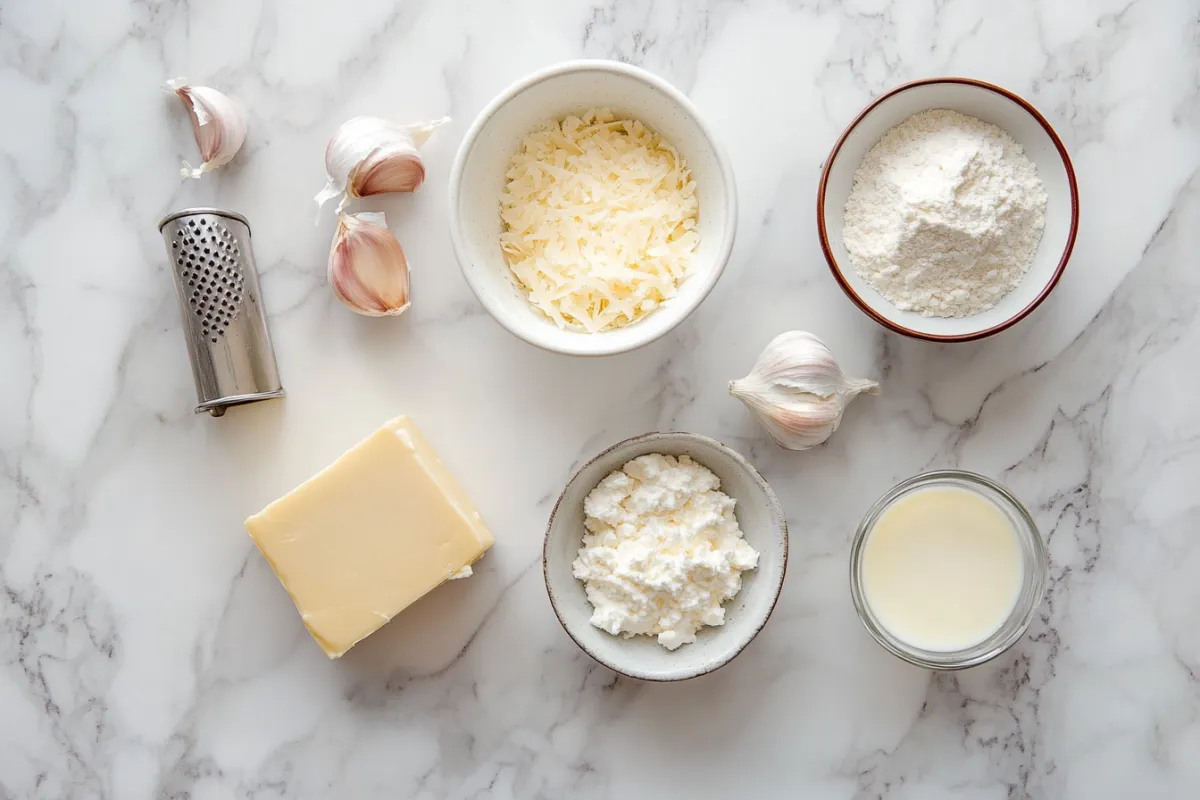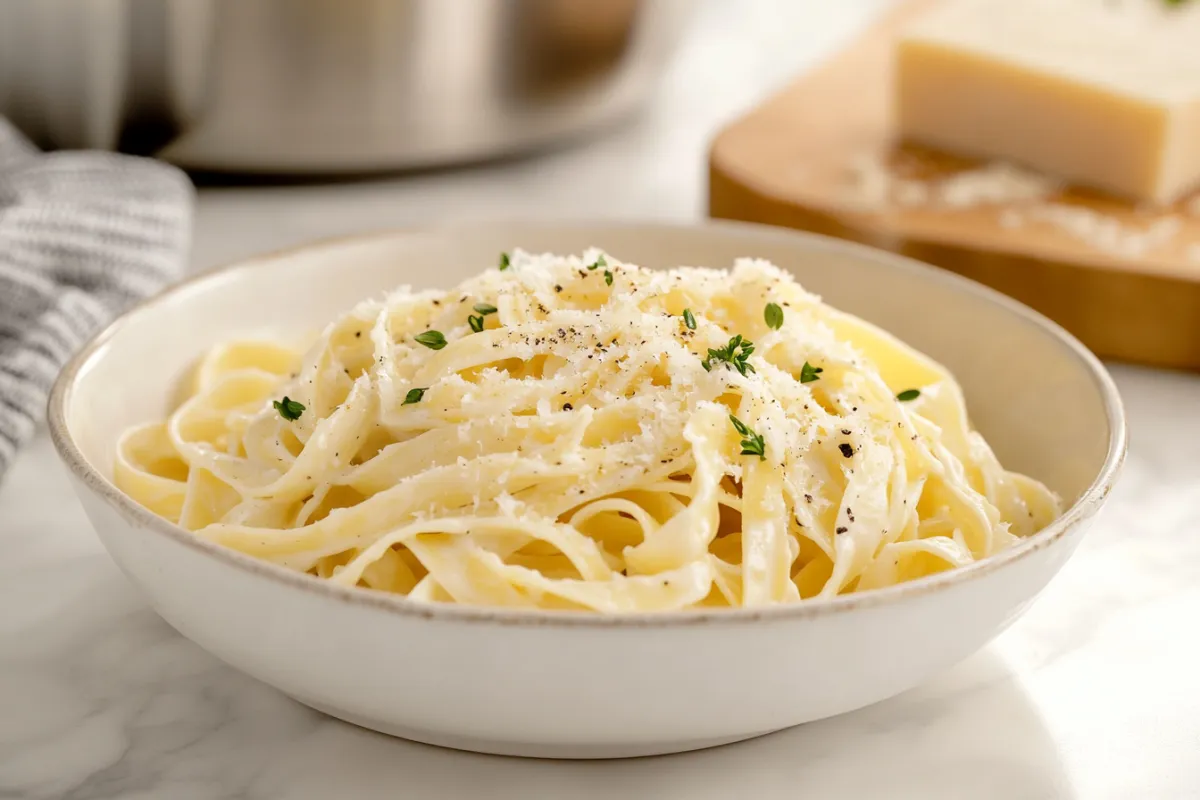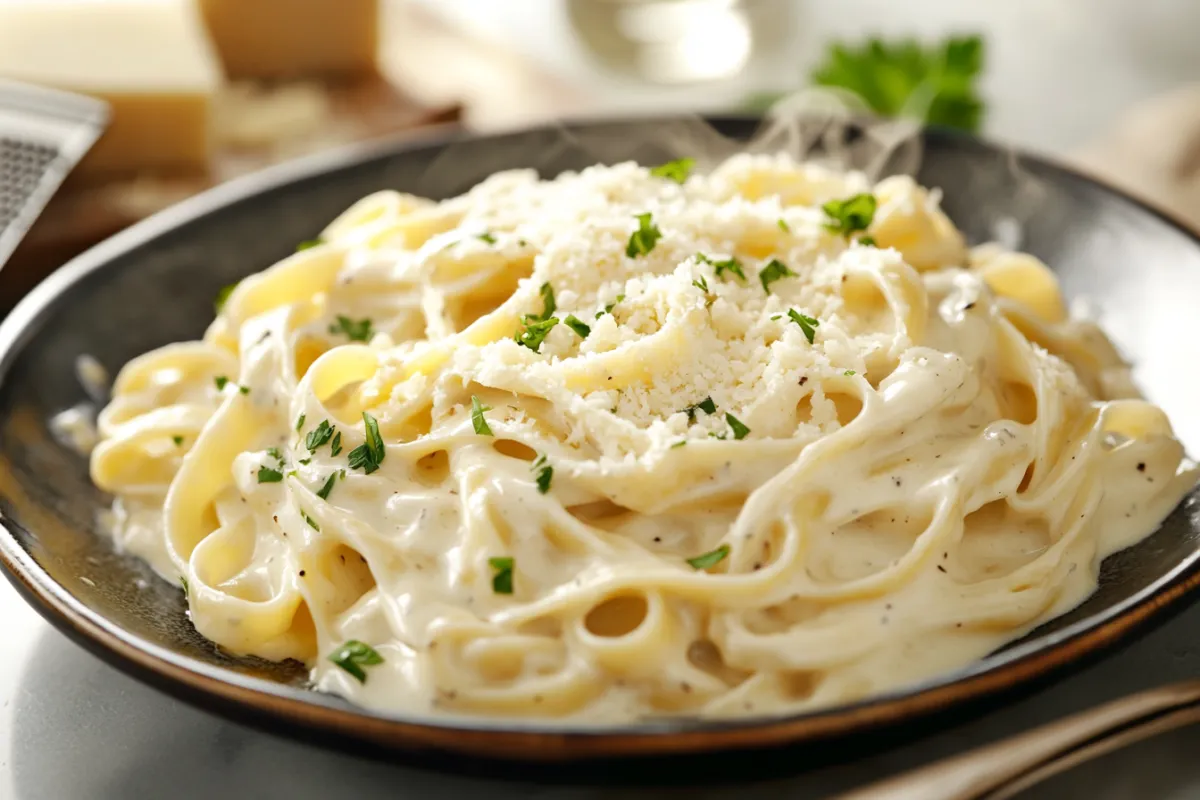Parmesan cheese is a beloved ingredient in pasta dishes, adding a rich, savory flavor that can elevate even the simplest recipes. However, melting Parmesan into a smooth, creamy sauce can be challenging due to the cheese’s low moisture content and the additives often found in pre-grated varieties. In this article, we will explore why Parmesan sometimes doesn’t melt as expected and provide techniques to help you achieve perfectly creamy Parmesan sauces. Let’s dive into the art of making Parmesan melt beautifully into your pasta dishes!
Why Parmesan Sometimes Doesn’t Melt Well
Parmesan is a hard cheese, and melting it smoothly requires specific conditions. If you’ve ever encountered clumps or stringy texture when trying to melt Parmesan, you’re not alone. Let’s look at some of the reasons why this happens and how you can overcome these challenges.
Additives in Pre-Grated Parmesan
Pre-grated Parmesan cheese is convenient, but it often contains anti-caking agents like cellulose to prevent clumping. Unfortunately, these additives can interfere with the cheese’s ability to melt smoothly. The cellulose prevents the cheese particles from fully integrating into the sauce, leaving you with an undesirable texture. For the best results, it’s always recommended to freshly grate your Parmesan cheese just before using it.
Moisture and Fat Content
Parmesan has a relatively low moisture content compared to other cheeses, making it more prone to clumping when exposed to high heat. Unlike softer cheeses like mozzarella, which melt into a creamy consistency due to their higher fat content, Parmesan requires more careful handling. The fat content also plays a role in how the cheese melts—Parmesan’s lower fat content makes it more likely to clump unless melted slowly and properly incorporated into the dish.
Temperature Control
One of the most common reasons Parmesan doesn’t melt well is due to improper temperature control. Heating the cheese too quickly or at too high of a temperature can cause it to clump or burn rather than melt. It’s essential to use low heat and add the cheese gradually to avoid these issues.
Best Types of Parmesan for Pasta
Not all Parmesan cheeses are created equal when it comes to melting. Here’s what to look for when choosing the best Parmesan for your pasta dishes.
Freshly Grated vs. Pre-Grated Parmesan
Freshly grated Parmesan is always the better choice for melting because it lacks the anti-caking agents that can prevent smooth melting in pre-grated versions. When you freshly grate Parmesan, you control the texture and quality of the cheese, allowing for better results in your sauces. Use a fine grater to ensure the cheese melts quickly and smoothly.
Aging Process
The aging process of Parmesan also affects how well it melts. Parmesan cheese that has been aged for a shorter period, around 12 to 18 months, tends to melt more smoothly than cheese aged beyond two years. Aged Parmesan can become brittle and dry, making it less likely to melt into a creamy sauce.
Alternatives to Parmesan
If you’re looking to switch things up or simply can’t find good-quality Parmesan, there are some great alternatives that also melt well in pasta dishes.
Pecorino Romano
Pecorino Romano is a tangy, salty sheep’s milk cheese that can be used in place of Parmesan. It melts similarly and offers a slightly sharper flavor, which works beautifully in many pasta dishes.
Grana Padano
Grana Padano is another hard Italian cheese similar to Parmesan but with a milder flavor. It melts well, making it a great option for creamy pasta sauces.
Techniques for Melting Parmesan in Pasta
Getting Parmesan to melt perfectly requires a few specific techniques. Let’s explore the best practices for creating a smooth, creamy sauce.
Low and Slow Cooking
The best way to melt Parmesan is by using a low and slow cooking method. Heating the cheese too quickly can cause it to seize up and clump. Add the cheese gradually to the dish, stirring constantly to allow it to melt evenly. Avoid bringing the sauce to a boil once you’ve added the cheese, as this can cause separation and an unappetizing texture.
Using a Roux
A roux—a mixture of butter and flour—serves as an excellent base for a creamy Parmesan sauce. By first melting the butter and mixing it with flour, you create a thickening agent that allows the cheese to incorporate smoothly without clumping. This method is especially useful when making Alfredo sauce or similar creamy pasta dishes.
Combining with Liquids
Adding a liquid, such as cream or milk, can help emulsify the Parmesan and create a creamy texture. The fat in the liquid helps the cheese melt evenly, preventing it from becoming stringy. Heavy cream is often the preferred choice for creating a rich, velvety sauce.
Incorporating Pasta Water
One of the best-kept secrets to creating a smooth Parmesan sauce is using starchy pasta water. When cooking pasta, some of the starch leaches into the water, making it an excellent emulsifier for the cheese. Adding a small amount of reserved pasta water to your Parmesan sauce helps the cheese blend smoothly and gives the sauce a luscious texture.
Step-by-Step Guide for Making Creamy Parmesan Sauce
Now that you know the best techniques for melting Parmesan, let’s walk through a simple recipe for making a creamy Parmesan sauce that pairs perfectly with your favorite pasta.

Ingredients Needed
- 2 tablespoons butter
- 1 tablespoon flour
- 1 cup heavy cream or whole milk
- 1 cup freshly grated Parmesan cheese
- 2 cloves garlic, minced (optional)
- Salt and pepper to taste
- 1/2 cup reserved pasta water
Preparation Steps
- Heat butter and garlic: In a large pan over medium heat, melt the butter and add the minced garlic (if using). Sauté until fragrant, about 1 minute.
- Make a roux: Add the flour to the butter and stir constantly to form a roux. Cook for about 1 minute until the flour is lightly browned.
- Add cream or milk: Slowly whisk in the cream or milk, continuing to stir until the mixture thickens and becomes smooth.
- Gradually add Parmesan: Reduce the heat to low and begin adding the Parmesan cheese in small handfuls, stirring constantly until the cheese is fully melted and incorporated.
- Incorporate pasta water: Stir in the reserved pasta water, a little at a time, until the sauce reaches your desired consistency.
Best Pasta Pairings
Garlic Parmesan Chicken Pasta: A Creamy Comfort Dish for All Occasions
This creamy Parmesan sauce works well with a variety of pasta types. Here are some ideal options:
Fettuccine
Fettuccine’s wide, flat noodles are perfect for holding onto creamy sauces like Parmesan. The sauce coats each strand of pasta, ensuring a rich, delicious bite.
Penne
Penne is a great option for creamy Parmesan sauces because its tubular shape allows the sauce to fill the center of each piece, creating a flavorful experience with every bite.
Linguine
Linguine is another flat noodle, though slightly narrower than fettuccine, making it ideal for lighter cream sauces.
Rigatoni
Rigatoni’s ridged surface makes it a great pasta choice for capturing thick, creamy sauces, ensuring the sauce clings to every bite.
Troubleshooting Common Issues
Even with the best techniques, problems can arise when melting Parmesan. Here are some common issues and how to fix them.
Clumping or Stringy Texture
If your Parmesan sauce turns out clumpy or stringy, it’s likely due to overheating the cheese or adding it too quickly. To avoid this, always melt the cheese over low heat and add it gradually.
Overly Thick or Too Runny Sauce
If your sauce is too thick, add a bit more pasta water or cream to thin it out. Conversely, if the sauce is too runny, you can add more Parmesan or let the sauce simmer for a few more minutes to thicken.
Balancing Flavor
Parmesan is naturally salty, so be cautious when adding additional salt. Start with a small amount, then taste the sauce before adding more. Freshly ground black pepper can also enhance the flavor without overpowering the cheese.
Enhancing Parmesan Flavor in Pasta Dishes
Once you’ve mastered the art of making creamy Parmesan sauce, consider adding other ingredients to elevate the flavor of your pasta dishes.
Adding Complementary Ingredients
- Garlic: Adds depth to the sauce.
- White wine: Provides acidity that balances the richness of the cheese.
- Lemon juice: Brightens the sauce and cuts through the creaminess.
Using Fresh Herbs
Fresh herbs can add a burst of flavor and color to your pasta dishes. Try incorporating:
- Basil
- Parsley
- Thyme
Combining with Other Cheeses
For an even creamier sauce, try mixing Parmesan with other cheeses like mozzarella or cream cheese. This combination adds a velvety texture and additional layers of flavor.
Storing and Reheating Parmesan Sauce

Refrigeration Tips
Store leftover Parmesan sauce in an airtight container in the refrigerator for up to 3 days. To reheat, warm the sauce over low heat, stirring frequently to prevent clumping.
Freezing Options
You can also freeze Parmesan sauce for future use. Pour the sauce into a freezer-safe container and store it for up to 3 months. Thaw the sauce in the refrigerator overnight before reheating.
FAQs
Can You Melt Parmesan Directly into Pasta?
While you can melt Parmesan directly into pasta, it’s best to combine it with a liquid like cream or pasta water to prevent clumping. The starch from the pasta water helps emulsify the cheese, creating a smooth sauce.
Why Does My Parmesan Clump Instead of Melt?
Clumping usually occurs when the cheese is added too quickly or heated at too high of a temperature. Using freshly grated Parmesan and adding it gradually over low heat can help prevent this issue.
How Can I Make Parmesan Sauce Creamier?
To make your Parmesan sauce creamier, try adding more cream or butter. This increases the fat content, allowing the cheese to melt more smoothly.
What’s the Best Parmesan for Pasta?
The best Parmesan for pasta is freshly grated and aged between 12 to 18 months. This provides the ideal balance of flavor and meltability.
Conclusion
Making Parmesan melt perfectly into pasta requires the right techniques and high-quality ingredients. By following the tips in this guide, you can create smooth, creamy Parmesan sauces that will elevate your pasta dishes to the next level. Don’t be afraid to experiment with different cheeses and complementary flavors to make the dish your own!
Related Articles
- Garlic Parmesan Chicken Pasta: Discover another delightful way to enjoy Parmesan cheese by incorporating it into a rich and flavorful garlic Parmesan chicken pasta.
- White Spaghetti Bolognese: Learn how to make a creamy white spaghetti Bolognese, another dish where melting Parmesan cheese can elevate the flavor.


1 thought on “How to Make Parmesan Melt in Pasta”